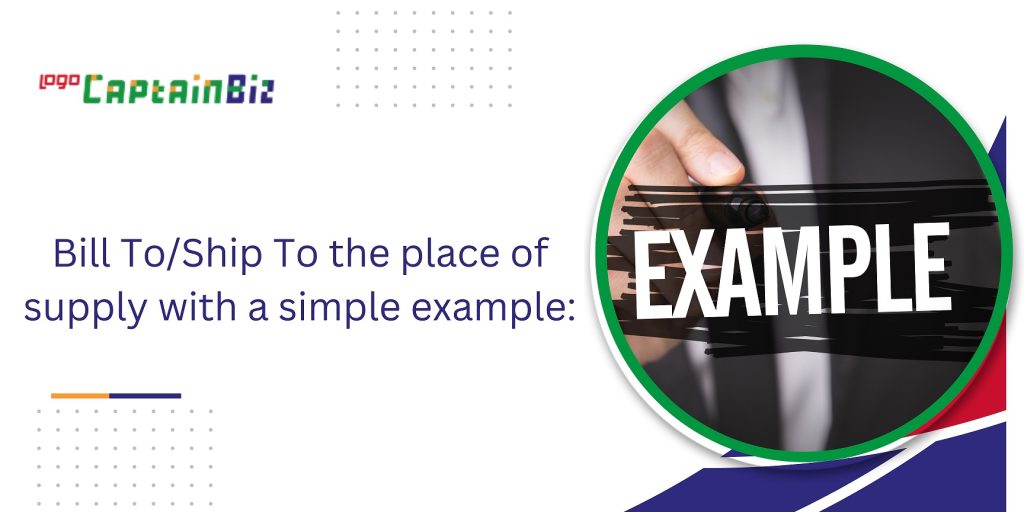In the world of business transactions, it is crucial to have a clear understanding of the documentation and invoicing requirements for bill-to/ship-to transactions. These transactions involve a buyer (the bill-to-party) who orders and specifies a different recipient (the ship-to-party) to whom the goods or services will be delivered to the place of supply.
Regarding these transactions, one important consideration is the place of supply. The place of supply refers to the place where goods are to be supplied for tax purposes. A registered person should issue “Tax Invoices” for inter-state supply and intra-state supply of taxable goods—tax invoices to be issued for B2B or B2C or for exports. The tax invoice will be issued before or during the supply of goods. To ensure compliance with tax laws, businesses engaged in bill-to-shipment-to-place of supply transactions must carefully document specific vital details.
First and foremost, they need to clearly identify both the bill-to-party and the ship-to-party on their invoices. This includes providing accurate names, addresses, contact information, and GST Registration Numbers. If an e-invoice is required to be issued by any of the suppliers in bill-to or ship-to cases, an e-invoice will be issued.
In the case of Bill To/ Ship To, the place of supply is a key determinant, as the tax invoices are issued by two different parties. In the ordinary course of business transactions, the place of supply is the place where the goods or services or both are consumed. But it is different in the case of bill-to-ship transactions. The taxpayers must be cautious while generating the tax invoices and determining the place of supply to be shown on the tax invoice.
Let’s understand Bill To/Ship To the place of supply with a simple example:

X Ltd is a registered taxpayer from Karnataka, and he receives an order from Y Ltd of Maharashtra, and X Ltd wants to supply directly to Y Ltd in Maharashtra, asking his principal Z, based out of Maharashtra, to save the transportation costs and time. For this transaction, there are two limbs/legs. Let’s understand the same
| S. No | Transaction | Place of Supply | Tax Invoice Details | Basis for availing Input Tax Credit |
| 1 | First Leg/Limb – X Ltd & Z Ltd | Karnataka | Z will issue a tax invoice with the following
Bill To – X Ltd Ship To – Y Ltd |
X will take ITC based on Y’s Tax invoice |
| 2 | Second Leg/Limb – X Ltd & Y Ltd | Maharashtra | X Ltd will issue a tax invoice with the following details
Bill To – Y Ltd |
Y Ltd will take ITC based on the Tax invoice issued by X Ltd |
In the above case for the first limb/leg, even though the goods are shipped within the state, the place of supply will be Karnataka as X Ltd is the main supplier, and on his instructions, the goods are being shipped by Z to Y. Z receives payment from X and the place of supply, in this case, will the Bill To party. For Bill To/Ship To cases, the place of supply in the first limb will be that of the leading supplier, i.e., Bill To Party. Taxpayers should make a note of this and issue the tax invoices accordingly.
For the second leg, the place of supply will be the location of the Y, the ultimate recipient of goods.
In the case of Bill to / Ship to transactions, an e-waybill must be issued by the party who is shipping goods. e-waybill is required to be issued even if the value of the goods is less than Rs50,000 if the leading supplier is from a different state. For the second leg, there will not be any e-waybill as there is no movement of goods.
If the goods shipped are exempted goods, then a “bill of supply” will be issued in place of the tax invoice.
If there is any price difference, Z will issue a credit note directly to X.
If the receipts of goods, i.e., Y wants to return the goods, then he can send it under the cover of a delivery challan cover and a credit note copy issued by the supplier, i.e., Z.
Bill To/Ship To transactions are commonly used in business, but the document to be issued differs from regular transactions. All the stakeholders must be cautious while generating the documents and determining the place of supply. Logo recommends that all taxpayers follow the provisions of the law to avoid any potential litigation, which will cost time and money.
Related Reports
Bill to-Ship to: Place of Supply, GST Rates and Compliance
Explore GST rates & compliance in bill-to-ship transactions. Learn about place of supply and taxation rules.
Benefits of E-waybill Registration – Enhance Efficiency and Reduce Checkpoint
This blog post discusses the features and benefits of e-way bill registration, such as reduced tax avoidance, faster movement of goods, and simplified documentation.

